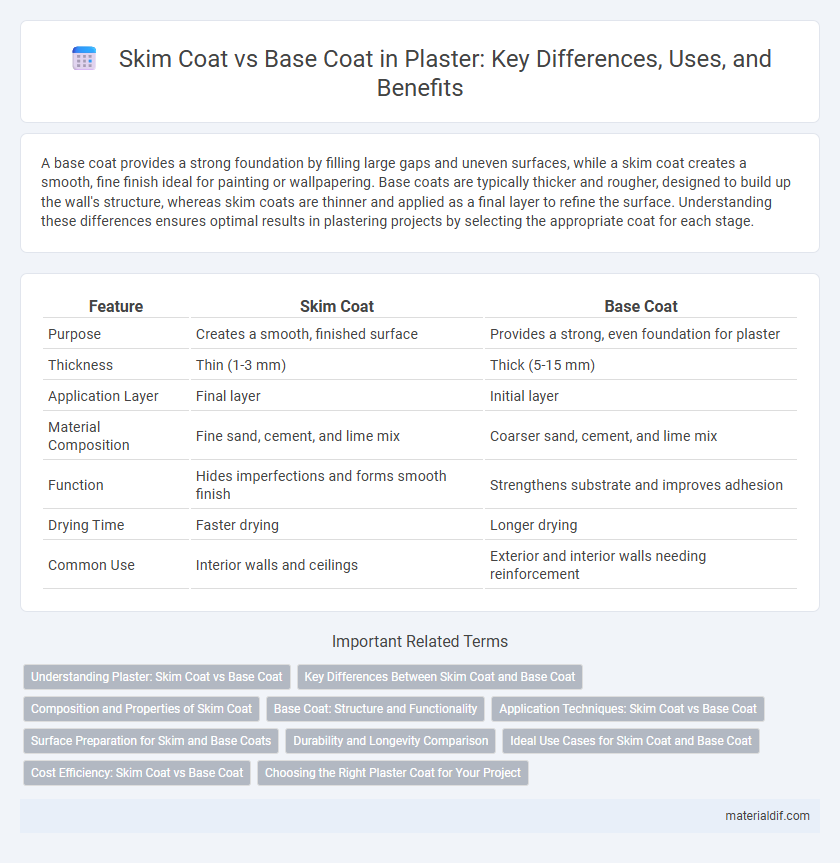A base coat provides a strong foundation by filling large gaps and uneven surfaces, while a skim coat creates a smooth, fine finish ideal for painting or wallpapering. Base coats are typically thicker and rougher, designed to build up the wall's structure, whereas skim coats are thinner and applied as a final layer to refine the surface. Understanding these differences ensures optimal results in plastering projects by selecting the appropriate coat for each stage.
Table of Comparison
| Feature | Skim Coat | Base Coat |
|---|---|---|
| Purpose | Creates a smooth, finished surface | Provides a strong, even foundation for plaster |
| Thickness | Thin (1-3 mm) | Thick (5-15 mm) |
| Application Layer | Final layer | Initial layer |
| Material Composition | Fine sand, cement, and lime mix | Coarser sand, cement, and lime mix |
| Function | Hides imperfections and forms smooth finish | Strengthens substrate and improves adhesion |
| Drying Time | Faster drying | Longer drying |
| Common Use | Interior walls and ceilings | Exterior and interior walls needing reinforcement |
Understanding Plaster: Skim Coat vs Base Coat
Skim coat and base coat serve distinct roles in plastering; the base coat provides foundational strength and thickness, ensuring surface evenness and durability. Skim coat is a thin, smooth layer applied over the base coat to create a flawless finish and enhance surface texture. Proper application of both coats is essential for achieving long-lasting, aesthetically pleasing plastered walls.
Key Differences Between Skim Coat and Base Coat
The key differences between skim coat and base coat lie in their composition and application purpose: a base coat is a thicker plaster layer applied to walls for leveling and providing structural strength, while a skim coat is a thin, smooth finish layer used to create a flawless surface. Base coat typically contains coarser aggregates and is 3/8 to 3/4 inch thick, whereas skim coat has a finer texture and is usually less than 1/16 inch thick. Skim coats enhance surface smoothness for painting or wallpapering, while base coats serve as foundational layers to even out rough surfaces.
Composition and Properties of Skim Coat
Skim coat is a thin, smooth plaster layer primarily composed of fine sand, cement, and water, often enhanced with additives like polymers to improve adhesion and flexibility. Its fine particle size and creamy texture allow it to create a uniform, crack-resistant surface that is ideal for finishing walls and ceilings. Skim coat properties include rapid drying, excellent workability, and the ability to fill minor surface imperfections, making it essential for achieving a flawless decorative finish.
Base Coat: Structure and Functionality
The base coat in plaster serves as the foundational layer, providing structural integrity and bonding strength to the substrate. It typically consists of a thicker, coarser mixture that helps to level uneven surfaces and reinforce durability. This layer ensures optimal adhesion for subsequent finishes like the skim coat, enhancing the overall longevity and stability of plastered walls.
Application Techniques: Skim Coat vs Base Coat
Skim coat application involves applying a thin, smooth layer of plaster to create a flawless surface, typically using a steel trowel for even spreading and fine finishing. Base coat application requires a thicker, more robust layer of plaster applied with a hawk and trowel, providing structural strength and a solid foundation for subsequent coats. Proper technique ensures that the base coat adheres well to the substrate and the skim coat achieves a polished, uniform finish.
Surface Preparation for Skim and Base Coats
Surface preparation for skim coat requires a clean, dry, and smooth base, free from dust, grease, and loose particles to ensure proper adhesion and a flawless finish. Base coat surfaces need thorough leveling and repair of cracks or unevenness to provide a stable foundation that supports the skim coat layer. Proper surface preparation enhances durability and helps achieve a uniform plaster finish, optimizing the overall quality of both skim and base coats.
Durability and Longevity Comparison
A base coat provides a strong, durable foundation for plaster applications, offering superior adhesion and structural stability that enhances longevity. Skim coats, being thinner and smoother, primarily improve surface finish but do not contribute significantly to the overall durability of the wall system. For extended lifespan and resistance to cracks or wear, base coats outperform skim coats due to their thicker, more robust composition.
Ideal Use Cases for Skim Coat and Base Coat
Skim coat is ideal for achieving a smooth, finished surface on walls with minor imperfections, making it perfect for final interior wall preparation before painting. Base coat serves as a foundational layer, providing structural strength and leveling uneven surfaces, often applied on exterior walls or rough substrates. Choosing between skim coat and base coat depends on the severity of surface defects and the desired finish quality.
Cost Efficiency: Skim Coat vs Base Coat
Skim coats generally offer higher cost efficiency for finishing surfaces as they require less thickness and fewer materials compared to base coats, making them ideal for smooth, final surface preparation. Base coats typically involve more labor and material costs due to their thicker application and reinforcement properties, suitable for structural leveling and repair. Choosing between a skim coat and base coat depends on the project's surface condition and budget constraints, with skim coats being more economical for minor imperfections and base coats necessary for more extensive substrate leveling.
Choosing the Right Plaster Coat for Your Project
Skim coat provides a smooth, finished surface ideal for walls and ceilings, enhancing paint adhesion and final appearance. Base coat offers structural strength and coverage, perfect for uneven or damaged surfaces requiring reinforcement. Selecting the right plaster coat depends on the project's needs: use base coat for durability and skim coat for a flawless finish.
Skim Coat vs Base Coat Infographic

 materialdif.com
materialdif.com